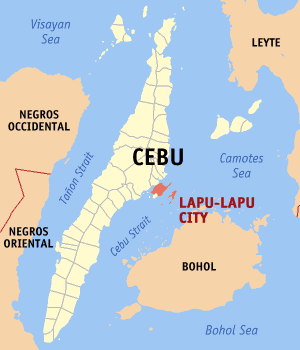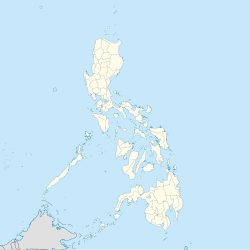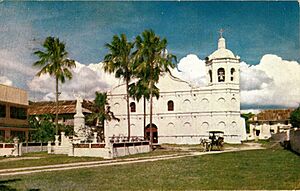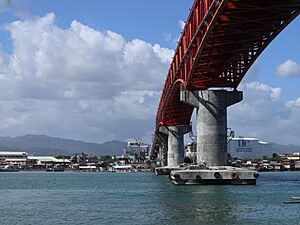Lapu-Lapu City facts for kids
Quick facts for kids
Lapu-Lapu City
Opon
|
|||
|---|---|---|---|
|
Highly urbanized city
|
|||
| City of Lapu-Lapu | |||
|
|||
| Nickname(s):
Historic Resort City
|
|||
| Anthem: Dakbayan sa Sidlakan (City of the East) |
|||

Map of Central Visayas with Lapu-Lapu City highlighted
|
|||
|
OpenStreetMap
|
|||
| Country | |||
| Region | Central Visayas | ||
| Province | Cebu (geographically only) | ||
| District | [[{{#property:P7938}} | — Lua error in Module:Wd at line 1804: attempt to index field 'wikibase' (a nil value).]] | ||
| Founded (Opon) | 1730 | ||
| Cityhood and renamed | June 17, 1961 | ||
| Highly urbanized city | January 23, 2007 | ||
| Named for | Lapulapu | ||
| Barangays | 30 (see Barangays) | ||
| Government | |||
| • Type | Sangguniang Panlungsod | ||
| Area | |||
| • Total | 58.10 km2 (22.43 sq mi) | ||
| Elevation | 70 m (230 ft) | ||
| Population
(2020 census)
|
|||
| • Total | 497,604 | ||
| • Density | 8,564.6/km2 (22,182.2/sq mi) | ||
| • Households | 129,652 | ||
| Demonym(s) | Oponganon | ||
| Economy | |||
| • Gross domestic product | ₱151.4 billion (2022) $2.675 billion (2022) |
||
| • Income class | 1st city income class | ||
| • Poverty incidence |
|
||
| • Revenue | ₱ 3,873 million (2022) | ||
| • Assets | ₱ 8,444 million (2022) | ||
| • Expenditure | ₱ 3,454 million (2022) | ||
| Service provider | |||
| • Electricity | Mactan Electric Company (MECO) | ||
| • Water | Metropolitan Cebu Water District (MCWD) | ||
| Time zone | UTC+8 (Philippine Standard Time (PST)) | ||
| ZIP code |
6015, 6016 (Mactan–Cebu International Airport)
|
||
| PSGC |
[https://psa.gov.ph/classification/psgc/?q=psgc/barangays/{{#pro000®code={{&provcode=
|
||
| IDD : area code | +63 (0)32 | ||
| Native languages | Cebuano | ||
Lapu-Lapu City is a busy and important city in the Central Visayas region of the Philippines. It's known as a "highly urbanized city," which means it's a big, developed city that manages itself. In 2020, about 497,604 people lived there.
The city was once called Opon but was renamed in 1961. It's part of Metro Cebu, a large group of cities in the Philippines. Even though it's on Mactan Island and is its own city, it's often grouped with the Cebu province for statistics. Lapu-Lapu City is the second most populated city in Cebu and the Central Visayas region, right after Cebu City.
Lapu-Lapu City is also home to the Mactan–Cebu International Airport, which is the second busiest airport in the Philippines. It opened in 1966 and connects the city to many places, especially in Asia.
Contents
History of Lapu-Lapu City
In the 1500s, Spain took control of Mactan Island. In 1730, a group of friars (religious brothers) officially founded the town of Opon as a Christian community. This town later became a city in 1961. It was renamed after Datu Lapulapu, a brave local leader.
Lapulapu is famous for leading his people to victory against the Portuguese explorer Ferdinand Magellan in 1521. This important event, known as the Battle of Mactan, is remembered at the Mactan Shrine in Barangay Mactan. Magellan and his 40 men landed there for supplies but were met by 1,500 local warriors. Magellan and some of his men were defeated.
The town of Opon was first set up by Augustinian missionaries in 1730. It was later given to the Jesuits in 1737, but then returned to the Augustinians. When the Philippine Revolution started in 1898, the people of Opon formed their own groups to fight for freedom.
During the Filipino-American War, a military government was put in place. Because the people of Cebu kept resisting, the American government took back military control on July 17, 1901. In 1905, Opon held its first local election, and Pascual dela Serna became the town president.
When World War II began in December 1941, Opon was attacked by Japanese planes because it had large oil storage tanks. Two of the fourteen tanks were blown up. Japanese forces landed in Cebu on April 10, 1942. Later, local resistance groups were formed to fight back.
In 1945, American forces helped liberate Cebu during the Battle of the Visayas.
The city is historically important as the site of the Battle of Mactan. On August 1, 1973, a special law declared the battle site a national shrine. This means it's a protected historical place. Mactan is also the birthplace of Leonila Dimataga-Garcia, who was the wife of Carlos P. Garcia, the fourth President of the Philippines.
Becoming a City
Manuel A. Zosa, a representative from Cebu, proposed the law to turn Opon into Lapu-Lapu City. This law, called Republic Act 3134 or the "City Charter of Lapu-Lapu," was signed on June 17, 1961, by Philippine President Carlos P. Garcia. Lapu-Lapu City officially started on December 31, 1961, with Mariano Dimataga, the last town mayor, becoming its first city mayor.
June 17 is now a special public holiday in Lapu-Lapu City to celebrate its charter anniversary.
Highly Urbanized City Status
On January 23, 2007, Lapu-Lapu was declared a "Highly Urbanized City" by President Gloria Macapagal Arroyo. This change was approved by the city's voters on July 21, 2007. Lapu-Lapu City became the 31st highly urbanized city in the Philippines.
Geography
Lapu-Lapu City is located on Mactan Island, which is a few kilometers away from the main island of Cebu. It is bordered by the main island of Cebu to the north, Cebu City and Mactan Channel to the west, the Camotes Sea to the east, and the town of Cordova to the south.
The city also includes some barangays (local districts) on the Olango Island Group. Lapu-Lapu City is connected to Mandaue on mainland Cebu by two bridges: the Mactan-Mandaue Bridge and the Marcelo Fernan Bridge.
Barangays
Lapu-Lapu City is divided into 30 barangays. Each barangay has smaller areas called puroks and some have sitios.
| PSGC | Barangay | Population | ±% p.a. | Area | PD | |||||
|---|---|---|---|---|---|---|---|---|---|---|
| 2010 | ha | acre | /km2 | /sq mi | ||||||
| 072226001 | Agus | Expression error: Missing operand for /.% | 19,525 | 15,767 | 1.37% | |||||
| 072226002 | Babag | Expression error: Missing operand for /.% | 30,839 | 22,756 | 1.96% | 307 | 759 | 10,000 | 26,000 | |
| 072226003 | Bankal | Expression error: Missing operand for /.% | 22,863 | 20,872 | 0.58% | 201 | 497 | 11,000 | 29,000 | |
| 072226004 | Baring | Expression error: Missing operand for /.% | 3,870 | 3,353 | 0.92% | 91 | 225 | 4,300 | 11,000 | |
| 072226005 | Basak | Expression error: Missing operand for /.% | 71,990 | 59,873 | 1.18% | 603 | 1,490 | 12,000 | 31,000 | |
| 072226006 | Buaya | Expression error: Missing operand for /.% | 19,078 | 16,072 | 1.10% | 271 | 670 | 7,000 | 18,000 | |
| 072226007 | Calawisan | Expression error: Missing operand for /.% | 15,740 | 11,454 | 2.05% | 957 | 2,365 | 1,600 | 4,300 | |
| 072226008 | Canjulao | Expression error: Missing operand for /.% | 14,451 | 13,245 | 0.56% | 156 | 385 | 9,300 | 24,000 | |
| 072226011 | Caubian | Expression error: Missing operand for /.% | 2,429 | 2,272 | 0.43% | |||||
| 072226009 | Caw‑oy | Expression error: Missing operand for /.% | 2,226 | 1,837 | 1.23% | 162,900 | 402,542 | 1.4 | 3.5 | |
| 072226010 | Cawhagan | Expression error: Missing operand for /.% | 694 | 638 | 0.54% | 55,900 | 138,134 | 1.2 | 3.2 | |
| 072226012 | Gun‑ob | Expression error: Missing operand for /.% | 37,989 | 31,219 | 1.26% | |||||
| 072226013 | Ibo | Expression error: Missing operand for /.% | 8,318 | 8,126 | 0.15% | |||||
| 072226014 | Looc | Expression error: Missing operand for /.% | 15,411 | 16,016 | −0.25% | |||||
| 072226015 | Mactan | Expression error: Missing operand for /.% | 50,964 | 33,465 | 2.72% | |||||
| 072226016 | Maribago | Expression error: Missing operand for /.% | 18,954 | 16,591 | 0.85% | |||||
| 072226017 | Marigondon | Expression error: Missing operand for /.% | 25,584 | 19,713 | 1.68% | |||||
| 072226018 | Pajac | Expression error: Missing operand for /.% | 22,116 | 17,402 | 1.54% | |||||
| 072226019 | Pajo | Expression error: Missing operand for /.% | 25,845 | 20,999 | 1.33% | |||||
| 072226020 | Pangan‑an | Expression error: Missing operand for /.% | 2,348 | 2,070 | 0.81% | |||||
| 072226021 | Poblacion | Expression error: Missing operand for /.% | 6,238 | 5,581 | 0.71% | |||||
| 072226022 | Punta Engaño | Expression error: Missing operand for /.% | 11,425 | 8,753 | 1.71% | |||||
| 072226024 | Pusok | Expression error: Missing operand for /.% | 32,791 | 28,810 | 0.83% | |||||
| 072226025 | Sabang | Expression error: Missing operand for /.% | 6,910 | 6,091 | 0.81% | |||||
| 072226031 | San Vicente | Expression error: Missing operand for /.% | 4,209 | 3,854 | 0.56% | |||||
| 072226026 | Santa Rosa | Expression error: Missing operand for /.% | 5,388 | 4,302 | 1.45% | |||||
| 072226027 | Subabasbas | Expression error: Missing operand for /.% | 7,961 | 6,288 | 1.52% | |||||
| 072226028 | Talima | Expression error: Missing operand for /.% | 5,973 | 5,734 | 0.26% | |||||
| 072226029 | Tingo | Expression error: Missing operand for /.% | 3,231 | 3,088 | 0.29% | |||||
| 072226030 | Tungasan | Expression error: Missing operand for /.% | 2,244 | 1,871 | 1.17% | |||||
| Total | 350,467 | Expression error: Unexpected < operator.% | [convert: invalid number] | Expression error: Unexpected / operator. | Expression error: Unexpected * operator. | |||||
Climate
| Climate data for Lapu-Lapu | |||||||||||||
|---|---|---|---|---|---|---|---|---|---|---|---|---|---|
| Month | Jan | Feb | Mar | Apr | May | Jun | Jul | Aug | Sep | Oct | Nov | Dec | Year |
| Mean daily maximum °C (°F) | 28 (82) |
29 (84) |
30 (86) |
31 (88) |
31 (88) |
30 (86) |
30 (86) |
30 (86) |
30 (86) |
29 (84) |
29 (84) |
28 (82) |
30 (85) |
| Mean daily minimum °C (°F) | 23 (73) |
23 (73) |
23 (73) |
24 (75) |
25 (77) |
25 (77) |
25 (77) |
25 (77) |
25 (77) |
25 (77) |
24 (75) |
23 (73) |
24 (75) |
| Average precipitation mm (inches) | 70 (2.8) |
49 (1.9) |
62 (2.4) |
78 (3.1) |
138 (5.4) |
201 (7.9) |
192 (7.6) |
185 (7.3) |
192 (7.6) |
205 (8.1) |
156 (6.1) |
111 (4.4) |
1,639 (64.6) |
| Average rainy days | 13.4 | 10.6 | 13.1 | 14.5 | 24.2 | 27.9 | 28.4 | 27.7 | 27.1 | 27.4 | 22.5 | 15.9 | 252.7 |
| Source: Meteoblue (modeled/calculated data, not measured locally) | |||||||||||||
Population and Languages
Most people in Lapu-Lapu City speak Cebuano, which is the local language. Tagalog and English are also commonly spoken and understood. Because many foreign visitors and residents live here, and there are many English as a Second Language (ESL) schools, you might also hear Japanese, Korean, and Chinese being spoken.
Economy
| Source: Philippine Statistics Authority |
|
Lapu-Lapu City is a key part of Metro Cebu, which is the second most important metropolitan area in the Philippines. The city has grown a lot economically since the 1990s.
The Mactan–Cebu International Airport, located in Lapu-Lapu City, is a major airport for both local and international flights. It has direct flights to many places in East and Southeast Asia. These connections have helped tourism become a big part of the city's economy. Many resorts are found in the city, especially along the eastern coast of Mactan Island.
The city also has several industrial zones, like the Mactan Export Processing Zone (MEPZ) and the Cebu Light Industrial Park (CLIP). Other large businesses include General Milling Company, a big food company, and Cebu Shipyard and Engineering Works, which builds and repairs ships.
Government and Leaders
| Years | Mayor |
|---|---|
| 1938–1967 | Mariano Dimataga |
| 1968–1986 | Maximo V. Patalinjug |
| 1986–1988 | Silvestre T. Dignos |
| 1988–1991 | Maximo V. Patalinjug |
| 1992–2001 | Ernest H. Weigel |
| 2001–2010 | Arturo O. Radaza |
| 2010–2019 | Paz C. Radaza |
| 2019–2025 | Junard Q. Chan |
| 2025-present | Ma. Cynthia K. Chan |
Mariano Dimataga's time as mayor was paused during World War II (1941–1945). During this time, Teodulo Tomakin, Eugenio Araneta, and Jorge Tampus served as appointed mayors. After the war, Mariano Dimataga returned to his position. As of July 17, 2025, Ma. Cynthia K. Chan is the current mayor of Lapu-Lapu City.
Transportation
Lapu-Lapu City has a great transportation system that makes travel and moving goods easy. The city is connected to the main island of Cebu by three important bridges: the Marcelo Fernan Bridge, the Mactan-Mandaue Bridge, and the newer Cebu–Cordova Link Expressway. These bridges cross the water between Mactan Island, where Lapu-Lapu City is, and Cebu Island.
The Mactan–Cebu International Airport (MCIA), located in Lapu-Lapu City, is a major airport for both local and international flights. It has been serving Cebu and the wider Central Visayas region since 1966. The airport has regular flights to many cities around the world, especially in Asia, including Singapore, Macau, Hong Kong, South Korea, Japan, and Taiwan. MCIA is the second busiest airport in the Philippines, only behind Ninoy Aquino International Airport in Manila.

Each year, MCIA handles a large number of passengers and flights. This shows how important it is for travel within the country and internationally.
On June 17, during the city's 63rd Charter Anniversary, Mayor Ma. Cynthia K. Chan talked about new projects. These include a large land reclamation project that will create a new commercial center, business area, and recreation park. Also, the Lapu-Lapu Expressway is being built to connect the Cebu-Cordova Link Expressway to the Mactan–Cebu International Airport. The Mactan–Mandaue Bridge connects Barangay Ibo in Lapu-Lapu City to Mandaue City. Other projects include an International Convention Center and a bridge connecting Sudtunggan-Gabi to Basak Cordova town.
Military Bases
Lapu-Lapu City is home to two military bases:
- Mactan–Benito Ebuen Air Base for the Philippine Air Force
- Philippines Naval Forces Central - Naval Base Rafael Ramos for the Philippine Navy
Notable People
- Lapulapu - A chieftain of Mactan and the first Philippine National Hero. He famously defeated Magellan.
- Janine Berdin - The grand winner of the second season of Tawag ng Tanghalan, a singing competition.
- Akiko Solon - A finalist from Star Power: Sharon Search For the Next Female Superstar.
- Aiah Arceta - A member of the popular Pinoy pop group Bini.
Images for kids
See also
 In Spanish: Lapulapu (ciudad) para niños
In Spanish: Lapulapu (ciudad) para niños
- List of renamed cities and municipalities in the Philippines
















